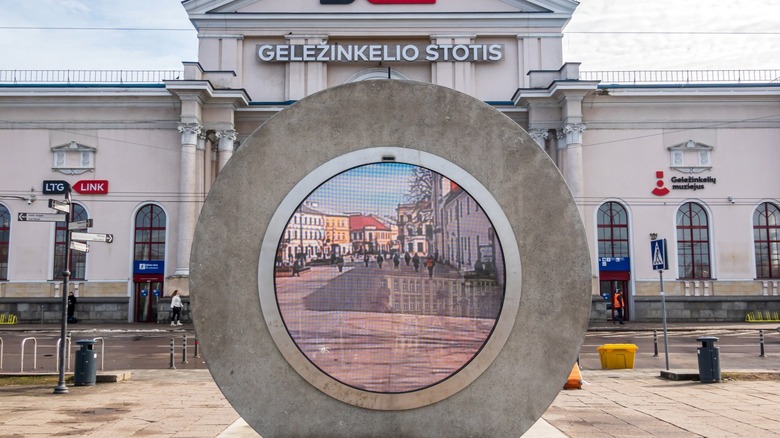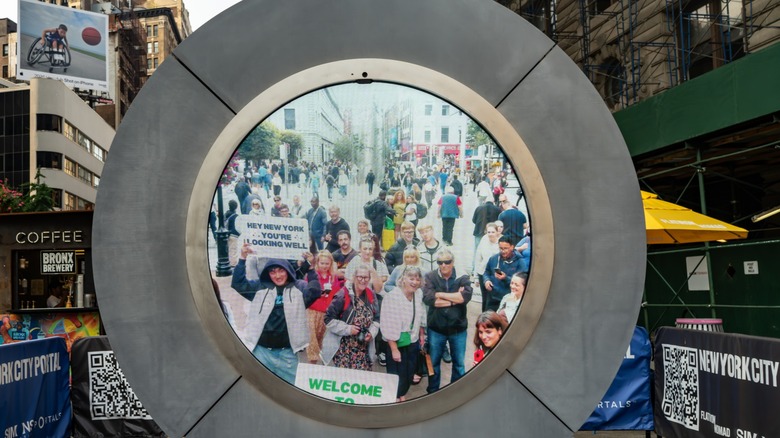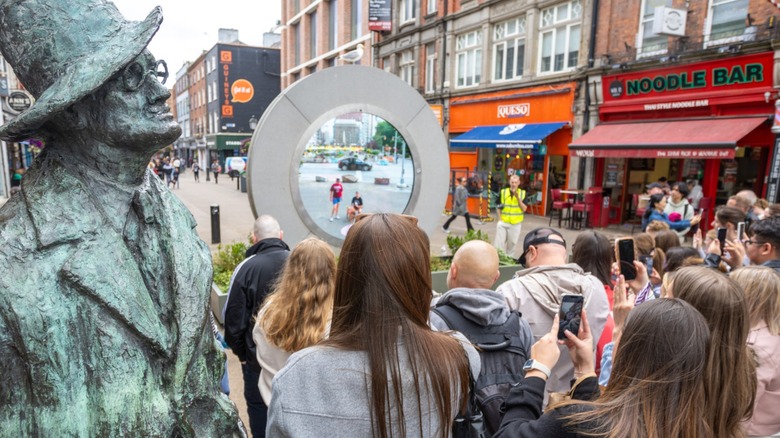Travel The Globe Via Livestream At These Awe-Inspiring Public Art Installations
In an increasingly polarized planet, where people are divided by religion, politics, and other issues, it may seem difficult to see a future that encompasses an interconnected, united world — but that is precisely the world imagined by Lithuanian artist, entrepreneur, and Portals founder Benediktas Gylys. Over a period of five years, the artist, along with a team of designers and engineers, worked steadfastly to see his vision come to light. In a press release, Gylys described this vision as "a bridge to a united planet that invites people of distant cultures to meet above borders, differences and narratives." And, with that in mind, the team launched its first completed project in May of 2021: a set of twin portals.
The "Portals", as they're aptly called, are both a grand technological feat and an interactive art experience. They are large, circular video installation sculptures which connect cities around the world via a livestream link. The first two cities chosen for the launch were Lublin, Poland, and the founder's hometown of Vilnius, the Lithuanian capital and a beautiful European city full of history and hikes. The livestream feeds were initially available 24/7 and unfiltered, allowing people to visit at all hours of the day and night to connect with residents from the twinned city.
Three years later, in May of 2024, two new Portals were established, linking Dublin, Ireland, with New York City. These two Portal sites, chosen because they are both well-known global cities, saw thousands of weekly visitors, with New York's Flatiron District seeing a 47% increase in foot traffic from 2023 to 2024.
The good, the bad, and the ugly of the Portals
The response to the Portals has been largely positive, with tourists and residents in each city waving hello and holding pre-printed signs with friendly greetings on them ("We [Heart] Dublin"). After all, there is no audio feed, so people have to connect through purely visual means. Cross-continental selfies, dance-offs, and games of rock-paper-scissors have all taken place — and even a sweet marriage proposal that had viewers on both sides cheering and clapping.
But not everyone approached the art installation with such altruistic intentions. As reported in The New York Times and other media outlets, there was so much inappropriate behavior within the first week of the Dublin-New York Portals opening that they were temporarily shut down. On the Dublin side, visitors showed swastikas and images of the World Trade Center attack, and some mooned the camera. Their counterparts in New York City weren't much better. An OnlyFans model flashed the Dublin audience, a stunt she allegedly performed to increase subscribers to her account on the adults-only platform. Benediktas Gylys told the Guardian, "We see a lot of love, light, smiles ... but we also have some darkness, attention-seeking people who are ... trying to jump on the narrative to get more views and followers."
As a result, more security protocols have been added to the measures already in place. There is a barrier around the Portals and on-site security to manage unruly behavior, and the feeds now run for limited hours rather than 24 hours a day. There was also talk of installing monitoring software, which would detect inappropriate content and blur the screen momentarily. A few months after its NYC launch, the U.S.-based Portal was relocated to Love Park in Philadelphia, the most populous and unexpectedly cosmopolitan city in Pennsylvania, where it remains as of the time of writing.
The future of the Portals
Bad behavior notwithstanding, the Portals are a massive hit and appear to be here to stay. The four installations combined have attracted millions of visitors and even celebrity acclaim, with stars like Margot Robbie commenting on them on social media.
As for the future of these sculptures, more are in the works and will continue to be built, pushing forward Benediktas Gylys' mission of a united world. A new Portal has already been set up in the northeastern state of Piauí in Brazil, launching in the spring of 2025 as of the time of writing. An Asia-based Portal is also in the pipeline, and the cities of London and Reykjavík have also been named by the founder as potential sites. Additionally, while the Portals used to be twinned, offering views of only one city, the feed now rotates every 180 seconds. Now the audience in Vilnius, for example, will be able to see a 3-minute slice of life in Ireland, Poland, the U.S., Brazil, and more, as future Portals are added.
So what makes the Portals worth a visit? There are certainly other impressive interactive art exhibits to see, like the immersive Van Gogh experience. But the Portals are unique in that they foster real-time, spontaneous connections with others around the globe — and seemingly innocent acts, like waving and dancing, have the potential to bring people together. So, if you're in the area, head to one of these sites, hold up a sign, or take a group photo to find out what it means — in this small way — to live on an interconnected planet.


